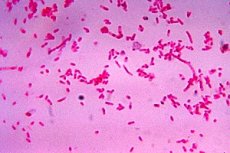New publications
The development of cancer may be linked to fusobacteria
Last reviewed: 02.07.2025

All iLive content is medically reviewed or fact checked to ensure as much factual accuracy as possible.
We have strict sourcing guidelines and only link to reputable media sites, academic research institutions and, whenever possible, medically peer reviewed studies. Note that the numbers in parentheses ([1], [2], etc.) are clickable links to these studies.
If you feel that any of our content is inaccurate, out-of-date, or otherwise questionable, please select it and press Ctrl + Enter.

Scientists have discovered one of the variations of Fusobacterium – Fusobacterium nucleatum – in every second colorectal tumor. This microorganism is quite common in the human body and is present in the oral cavity of healthy people. Now, a certain type of this bacterium is associated with increased risks of tumor recurrence and metastasis, as well as with an unfavorable prognosis for post-therapeutic survival. Such results were announced by representatives of the American F. Hutchinson Cancer Center.
Colorectal cancer is considered a very common malignant pathology with damage to the colon or rectum. Among the most common clinical symptoms, the leading ones are intestinal dysfunction and the appearance of blood in the feces. Diagnosis is based on information obtained during colonoscopy. The main method of treatment is surgery to resect the affected intestinal segment, followed by chemotherapy. The disease most often affects older people - from fifty years and older.
Colorectal cancer is the second leading cause of death among adults (American Cancer Society data for the United States).
Using metagenomic sequencing, specialists have identified colonies of Fusobacterium nucleatum bacteria in colorectal cancer lesions. Interestingly, these microorganisms are normally present in the oral microflora.
The researchers studied colorectal tumor tissues taken from two hundred operated patients, simultaneously measuring the presence of fusobacteria in them. As a result, phenotypic and genetic heterogeneity of these microorganisms was revealed. It turned out that fusobacteria are divided into two types: C1, living in the oral cavity, and C2, predominating in the tissues of colorectal malignant neoplasms.
Category C2 bacteria were found in almost every second colorectal cancer sample. In addition, a large number of such microorganisms were seeded in fecal mass elements of patients with this disease. This phenomenon was closely associated with increased dynamics of malignant lesion growth, early recurrence of neoplasm and formation of metastases, as well as unpromising therapeutic prognosis.
According to experts, identifying different types of fusobacteria and determining the involvement of one of the types in the development of colorectal cancer plays an important role in the early detection of this pathology. In addition, there are now opportunities to improve existing treatment measures using modifications of microorganisms for the purpose of transporting medicinal substances directly into the tissues of the neoplasm.
Details of the study are presented on the Nature journal page
